#the colour and the shape era
Explore tagged Tumblr posts
Text



Are there any albums you’re looking forward to in 1998?
#takes one to know one#I wish the gif quality was better#taylor hawkins#dave grohl#foo fighters#jeff buckley#1998#the colour and the shape era#my gifs#grohlkins#he is the reason why I love Grace as much as I do#I wouldn’t have found it if not for T
299 notes
·
View notes
Text









1. Addax nasomaculatus (addax) | 2. Litocranius walleri (gerenuk) | 3. Tragelaphus eurycerus (bongo) | 4. Oryx gazella (gemsbok) | 5. Bos taurus (Aubrac cattle) | 6. Ovis canadensis (bighorn sheep) | 7. Sivatherium | 8. Pakicetus | 9. Diceros bicornis (black rhinoceros)
#could it be...... that I'm finally posting those ungulates...... woah#forgot about this project for a second but here are the sketches I got done#not saying I won't ever continue but thank you all for suggestions and apologies to those whose fave ungulates I didn't yet get to#I have always liked oryxes they are so massive but also so sharply shaped#new among my favourites is the bongo! Hadn't ever looked into those guys and shame my willppoer ended before I got to colours#very shaped creature very shaped horns very nice sharp stripes! and their striped mane going all the length of their back! very colored als#but glad there's love to all kinds of ungulates out there <3#also shoutout to our ancient boy shivatherium and even more ancient boy pakicetus bringing the era diversity here#what sparked my obsession this time was looking into all kinda prehistoric carnivore ungulates that had existed
214 notes
·
View notes
Text

he
#i used to hoard all of my old school papers with the thought of one day; i'll use them to draw on instead of letting them go to waste!#...........yeah the paper gain was faster than the usage. piled up very fast. worst era of my life my room was always so MESSY skdjffdkjhd#some survived though! thats why you see some very basic chem in the back :P hated it back then and i still hate it now#UHM#oh!!! yeah the art. dskhjdfsjhf. found two markers at random with colours that work rlly nicely together so ive just been doodling like crz#and i rly like how this one turned out.. check out that schnozz!#i wish i was better at retaining simple flowy shapes in my art; especially when i try to finish a sketch digitally. i tend to lose it!#i'll get better at it but only with time! alas#OKAY. IM DONE RAMBLING#LOL.#okay#shadow milk cookie#cookie run kingdom#crk#crk fanart#mystuff#doodle
84 notes
·
View notes
Text
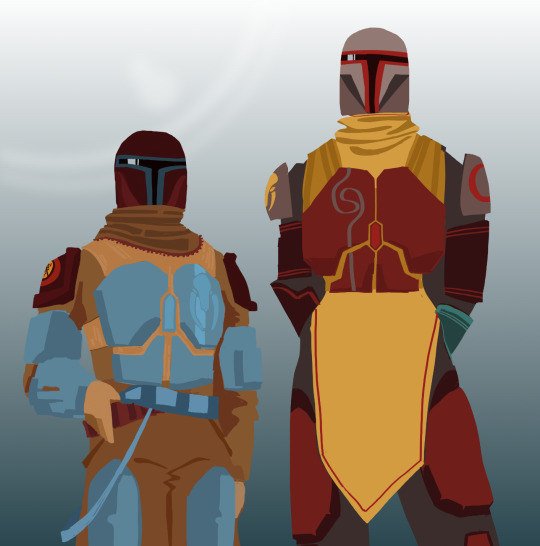
Kal Skirata and Vhonte Tervho armour redesign for edges of providence on AO3
ID in ALT
#mandalorian culture#Star Wars fic rec#Star Wars fanart#described#kal skirata#vhonte tervho#listen I know NOW that tervho is supposed to be a petite redhead kinda woman but listen. listen.#I always pictured her to be rlly tall and scary strong so thats what I drew#she adopts cody and fox in this fic and I wanted them to be a part of her armour#well this is the armour and they pick their colours later based on that#in my shapes and colours era#art#star wars
51 notes
·
View notes
Text
ily limited colour palettes <3
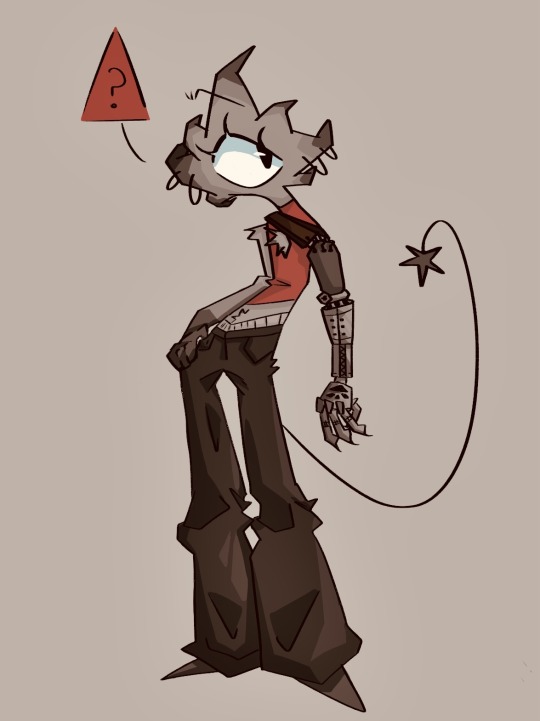
[ID: a digital drawing of an original stylised Flatland character named Liz on beige background.
Liz is a thin humanoid creature with a seven point star-shaped head, one eye, light grey skin that fades to dark grey on the edges of her head and forelimbs, a metal prosthetic left forearm and a long tail with a star on the end.
They are wearing a sleeveless red top with a high neck and chest cutout, low-waisted black baggy jeans with off-white boxers peeking above the hem, and double hoop earrings.
Liz is stood with a slouch, with her left arm hanging down and her right arm half-hidden behind her torso. Her right thumb is in her pocket and her knuckles are against her hip. Her tails is curved into a backwards ‘C’ shape. They have a mildly intrigued expression with a raised eyebrow. There is a red triangular speech bubble by her with a question mark.
End ID].
ever-so-slightly-different version under the cut, blade warning

[ID: the same drawing of Liz as above, but there is a silver, machete-like blade protruding from the palm of her prosthetic hand. End ID.]
#everyday we stray further away from victorian era fashion#messed w the colours since they were too dark to appreciate the details#i haven’t drawn her since january…what happened to me#i need to show off her personality better#i feel like i’ve made her seem too innocent as if she hasn’t 1. killed a man 2. attempted to kill a man and 3. is plotting to kill again#giving her Vance’s slightly narrower eye shape bc her round eye also makes her too innocent looking#tw blade#flatland#oc#elizabeth huntsworth#📎
16 notes
·
View notes
Note
Hey 🤍 It's Jessi again. Are you ready for it? A new week full or opportunities is lying ahead of you. Think of one special or little thing (however small) you're looking forward to this week. (feel free to share, if you want to) Btw thank you for all your sweet replies 🤍 I promise I'm reading all of them, even if I can't always react to all of them. Here's what I'm looking forward to: Writing to you guys next sunday ☺️
Thank you, you're an absoulte angel and your message made me smile yet again 🌟💛✨*
I wish i had something better to say but right now what i'm looking for the most is not having covid anymore lol. Although that means more piano time for me + more indulging in my mum's cooking and baking since i don't have to go to my college town, so it's not all bad i guess 🤔
I hope you have a great week! 💛
#and more time spent in my room? i've redecorated a while ago and have a few very bushy branches of oak (with lots of leaves)tied on the wall#and now when im in my bed or sitting at my desk im basically under a tree#which i've also decorated with star shaped fairy lights and hung eras tour bracelets from#next step is making colourful origami animals which are going to inhabit the branches#i love being here#my room is a whimsical fairy forest
1 note
·
View note
Note
I mean this with all the love in my heart, I adore how much your interests are so different from each other
Thank you for the reblog c: your profile aesthetic is really nice I'm jealous
ahh thank you so much !! 😭 im so happy you like my profile im always fretting over it and trying to make it perfect haha, you're very sweet <3 and i love your profile aesthetic too!
#my biggest flex is that i took my header image myself 😗#at the eras tour#i have better photos but that one matched the colour scheme and header shape perfectly#moots <33
1 note
·
View note
Note
Can you post something about different kinds of soulmates? The name on the wrist or red strings are nice but a little overused, maybe. Idk. Do you have anything different?
50 Types of Soulmates in Literature
The soulmate trope might feel pretty cliche to most but I love exploring them (great short story material, esp if you want to twist it into horror/thriller/non romance). Thanks for the ask! I hope this list is what you were looking for:
Fate-Driven Soulmates
1. Shared Dreams – They meet in their dreams every night/[idea] after they turn [age].
2. Reincarnation– They reincarnate in every era and are destined to meet each time.
3. Aura Bonds – Their auras [change] when they’re near each other.
4. Mirror Messages – They see the other’s face in the mirror when they turn [age].
5. Starbound – Their soulmate’s birth constellation forms on them after their first meeting.
6. Heartbeat Match – Their pulses sync when they meet and get more uneven when they’re apart after that.
7. Shared Memories – They have flashbacks of past lives together.
8. The First Words – Their first spoken words to each other are tattooed on their skin.
9. Fragrance – They recognise each other by a unique scent only one’s soulmate carries (i.e. in the world you can only smell roses on your soulmate).
10. Scars – They have matching scars in the same place since their birth.
11. Colour - They only start seeing colour after meeting their soulmate. Can be changed to sound, touch, smell, etc.
Cultural Soulmates
12. Mehndi Marks - In Indian/Middle Eastern cultures, your soulmate’s name appears in your mehndi/henna.
13. Karmic Threads - In Buddhist traditions, invisible karmic bonds pull them toward one another.
14. Feng Shui Alignment – Their energies perfectly balance according to the Feng Shui elements.
15. Ancestor's Blessing – Their names are revealed through a ritual that summons past ancestors.
16. Name in Flames – In some folk traditions, a fire ceremony reveals their soulmate’s initials in the embers.
17. Feather Match – They exchange feathers that later glow when their soulmate is near.
18. Shared Songlines – In Aboriginal traditions, their paths align on the same Songline.
19. Palm Reading Prophecy – Their soulmate’s features or initials are foretold in their palm lines.
20. Dance of Fate – In certain cultures, a soulmate is revealed during a traditional dance when they naturally pair up.
21. Persian Tea Leaves – Their names appear during tea-reading rituals.
Object-Based Soulmates
22. Lock and Key – Everyone is born with a keyhole shape. When you turn [age] you’re blessed with a key that only fits into your soulmate.
23. Shared Journal – They write in the same journal without knowing how.
24. Twin Trinkets – When born, each person receives a magical [trinket]. Your soulmate has its twin.
25. Compass of Love – A compass always points them toward their soulmate.
26. Two Halves – They carry two halves of the same [object].
27. Enchanted Maps – A map updates itself with their location when they’re near.
28. Eternal Rings – Rings burn hot or glow when their soulmate is close.
29. Song – When they turn [age] they hear a song sung in their soulmate’s voice. (Interesting: in this world, MC hears nothing. They think they don’t have one, rly their soulmate is just mute).
Connection Through Nature
30. Tree of Life – Their world has a special garden you go to when you’re [age]. In the garden, a tree starts to grow when two soulmates are near. Note: if they ‘break up’ or one dies, the tree wilts and dies too.
31. Blooming Flowers – When your soulmate is born, you get a flower bud [different for each]. When you meet the first time, this bud goes into full bloom. If you pass without meeting, it dies. This continues till you actually meet, and the flowers finally [fall off?]
32. Animal Guides – At birth you’re assigned a spirit animal who leads you to your soulmate when the time is right. (Ooh maybe your spirit animals are soulmates too OR hmo: they’re enemies! You haven’t met your soulmate yet because your spirit animals are doing everything to keep you [and themselves] apart).
33. Shifting Shadows – Their shadows always reach toward the other. When you sleep, your shadows break away and meet each other.
34. Bound by Seasons – They only meet during a specific season each year. Kind of like a Divergent ‘born into a season’ thing. (But what if a Summer and Winter end up being fated? But they can’t survive in each other’s seasons. [omg Tinkerbell] lol).
35. Ocean Whispers – It’s said if you go to the ocean’s shore and say something there your soulmate will hear it when they go to the shore. (MC’s soulmate hates the ocean. They’ve never been. One day they finally go, and sit for hours as they listen to messages from their soulmate, who apparently lives by the ocean and has been calling to them every night).
36. Star-Written Names – When you turn [age] only you see a name written in the stars. That’s your soulmate’s name.
Unconventional Soulmate Tropes
37. Memory Keepers – One soulmate is bound to forget each other in each new life, and the other is fated to remember and find them. The other only remembers if and when they meet.
38. Parallel Lives – They exist in parallel universes but see glimpses of each other via [plot].
39. Shared Illness – They feel each other’s pain, sickness, and recovery.
40. Shared Mortality – They can only die when they’re together.
41. The Final Wish – When you turn [age] you get to make a wish and your soulmate has to fulfil it in order for you to meet.
42. The Sacrificial Lamb – One is destined to save the other through ultimate sacrifice.
43. The Time Loop – They’re stuck in a loop, meeting repeatedly until they get it right.
44. Dual Souls – They share one soul in two bodies, feeling incomplete without the other.
45. The Undying and the Mortal – One reincarnates endlessly, always finding their soulmate, if they fail to find them, their soulmate will not reincarnate and die forever. Except, you don’t know who’s the immortal one.
46. Time Stopper: Time stops when you’re with your soulmate. It starts again when you’re apart.
Sense-Based Soulmates
47. Sight: When you close your eyes you can see what they’re seeing.
48. Warmth: You feel physically cold everytime you’re without your soulmate. Your heart turns colder every year, till when you’re [age] you both die if you haven’t met.
49. Colour: You can’t see your soulmate’s eye/hair colour till your first meeting. The issue: they don’t know the colour, so often overlook this change. (Many resort to checking a colour chart every day till they see a new colour).
50. Touch: You can’t feel anything till your soulmate touches you for the first time. Everything simply feels like its weight, not texture.
Looking For More Writing Tips And Tricks?
Check out the rest of Quillology with Haya; a blog dedicated to writing and publishing tips for authors!
Instagram Tiktok
#hayatheauthor#haya's book blog#haya blogs#writing community#quillology with haya#writing tools#writer things#writing advice#writer community#writing techniques#writing prompt#writing stuff#creative writing#ya writing advice#writing tips and tricks#writer tools#writers of tumblr#writer blog#writers block#quillology with haya sameer#writers on tumblr#writerscommunity#writer stuff#author help#author advice#author#writing inspiration#writeblr#novel writing#on writing
3K notes
·
View notes
Text
Fantasy Guide to Interiors

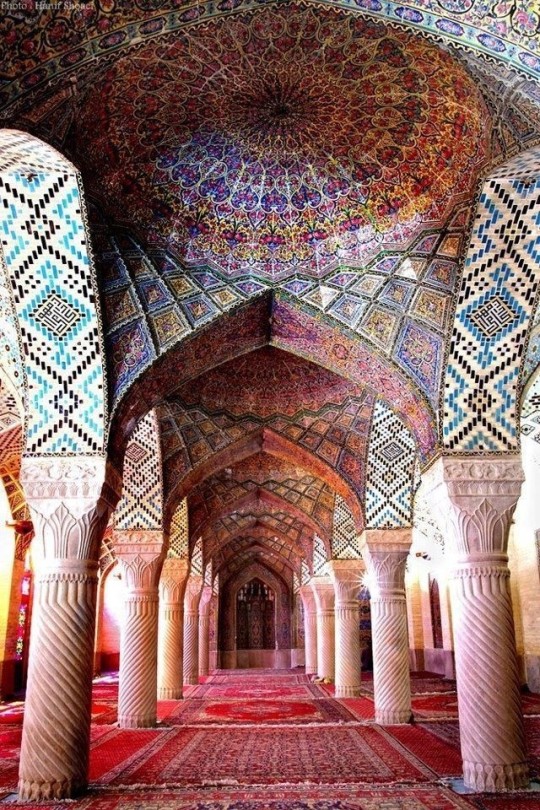
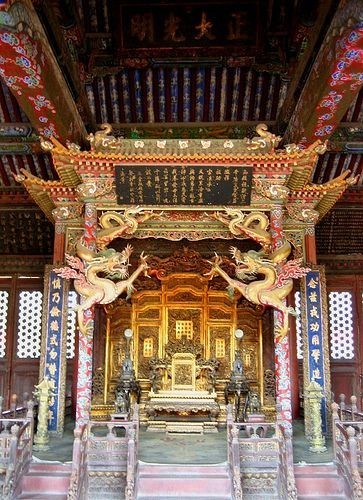
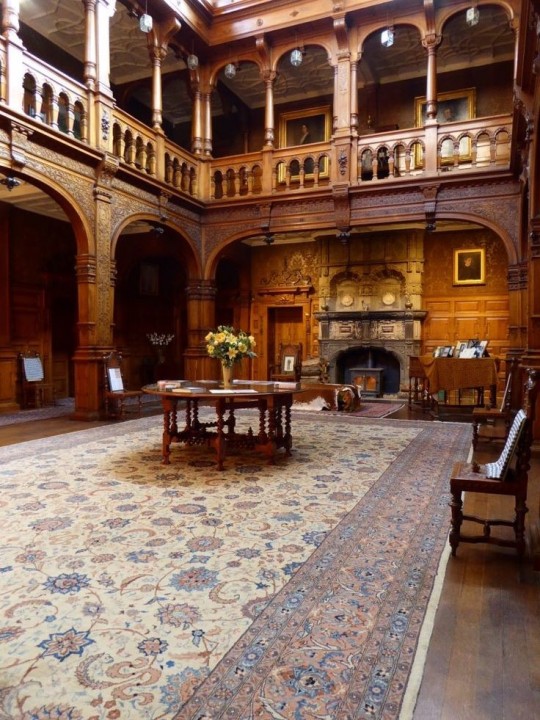
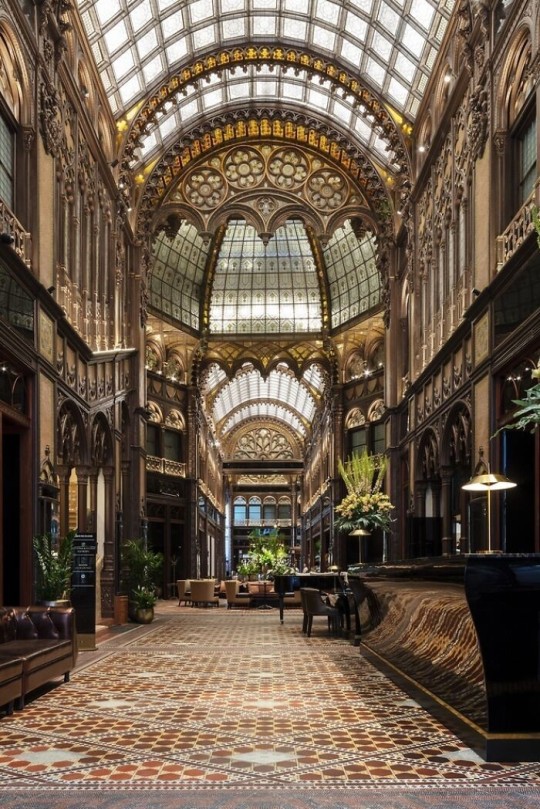
As a followup to the very popular post on architecture, I decided to add onto it by exploring the interior of each movement and the different design techniques and tastes of each era. This post at be helpful for historical fiction, fantasy or just a long read when you're bored.
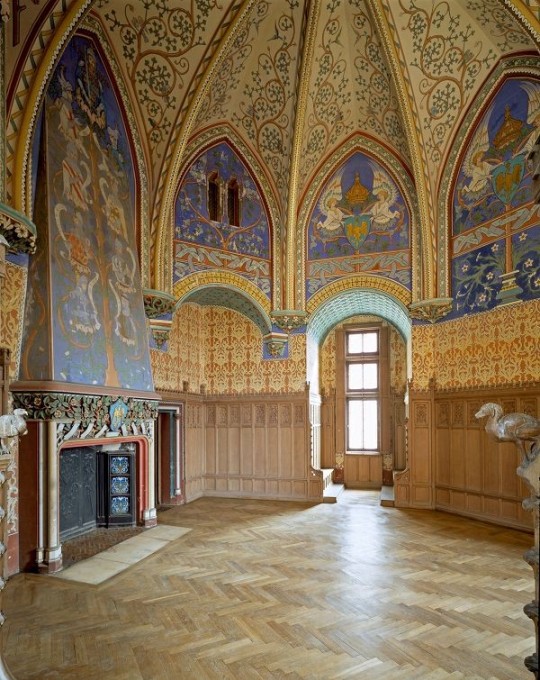
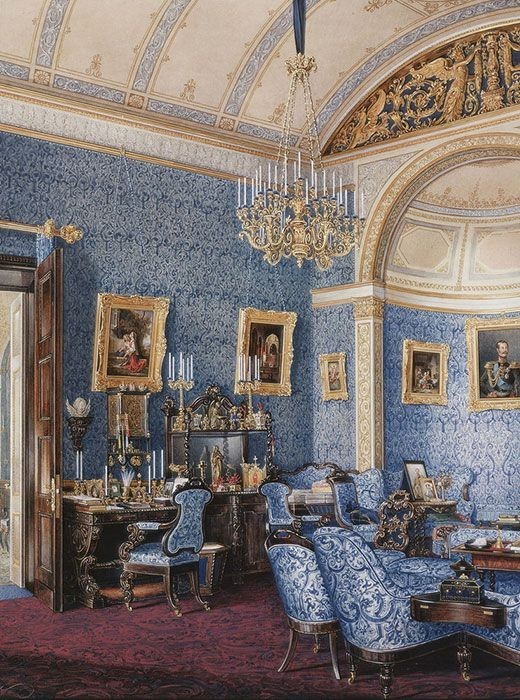
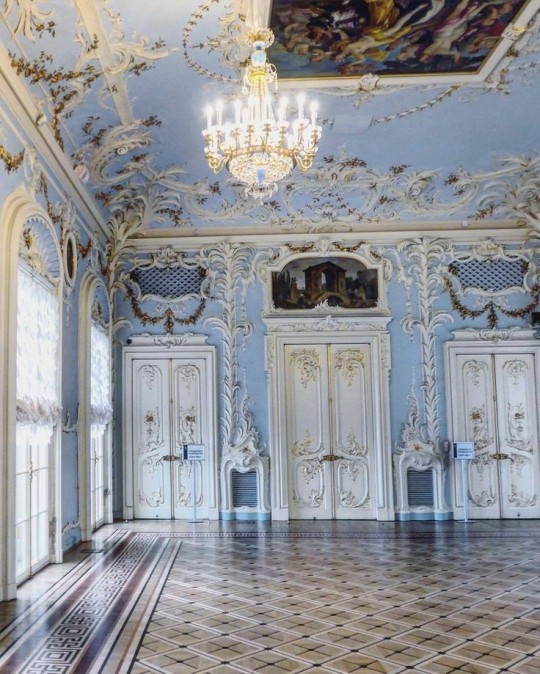
Interior Design Terms
Reeding and fluting: Fluting is a technique that consists a continuous pattern of concave grooves in a flat surface across a surface. Reeding is it's opposite.
Embossing: stamping, carving or moulding a symbol to make it stand out on a surface.
Paneling: Panels of carved wood or fabric a fixed to a wall in a continuous pattern.
Gilding: the use of gold to highlight features.
Glazed Tile: Ceramic or porcelain tiles coated with liquid coloured glass or enamel.
Column: A column is a pillar of stone or wood built to support a ceiling. We will see more of columns later on.
Bay Window: The Bay Window is a window projecting outward from a building.
Frescos: A design element of painting images upon wet plaster.
Mosaic: Mosaics are a design element that involves using pieces of coloured glass and fitted them together upon the floor or wall to form images.
Mouldings: ornate strips of carved wood along the top of a wall.
Wainscoting: paneling along the lower portion of a wall.
Chinoiserie: A European take on East Asian art. Usually seen in wallpaper.
Clerestory: A series of eye-level windows.
Sconces: A light fixture supported on a wall.
Niche: A sunken area within a wall.
Monochromatic: Focusing on a single colour within a scheme.
Ceiling rose: A moulding fashioned on the ceiling in the shape of a rose usually supporting a light fixture.
Baluster: the vertical bars of a railing.
Façade: front portion of a building
Lintel: Top of a door or window.
Portico: a covered structure over a door supported by columns
Eaves: the part of the roof overhanging from the building
Skirting: border around lower length of a wall
Ancient Greece
Houses were made of either sun-dried clay bricks or stone which were painted when they dried. Ground floors were decorated with coloured stones and tiles called Mosaics. Upper level floors were made from wood. Homes were furnished with tapestries and furniture, and in grand homes statues and grand altars would be found. Furniture was very skillfully crafted in Ancient Greece, much attention was paid to the carving and decoration of such things. Of course, Ancient Greece is ancient so I won't be going through all the movements but I will talk a little about columns.
Doric: Doric is the oldest of the orders and some argue it is the simplest. The columns of this style are set close together, without bases and carved with concave curves called flutes. The capitals (the top of the column) are plain often built with a curve at the base called an echinus and are topped by a square at the apex called an abacus. The entablature is marked by frieze of vertical channels/triglyphs. In between the channels would be detail of carved marble. The Parthenon in Athens is your best example of Doric architecture.
Ionic: The Ionic style was used for smaller buildings and the interiors. The columns had twin volutes, scroll-like designs on its capital. Between these scrolls, there was a carved curve known as an egg and in this style the entablature is much narrower and the frieze is thick with carvings. The example of Ionic Architecture is the Temple to Athena Nike at the Athens Acropolis.
Corinthian: The Corinthian style has some similarities with the Ionic order, the bases, entablature and columns almost the same but the capital is more ornate its base, column, and entablature, but its capital is far more ornate, commonly carved with depictions of acanthus leaves. The style was more slender than the others on this list, used less for bearing weight but more for decoration. Corinthian style can be found along the top levels of the Colosseum in Rome.
Tuscan: The Tuscan order shares much with the Doric order, but the columns are un-fluted and smooth. The entablature is far simpler, formed without triglyphs or guttae. The columns are capped with round capitals.
Composite: This style is mixed. It features the volutes of the Ionic order and the capitals of the Corinthian order. The volutes are larger in these columns and often more ornate. The column's capital is rather plain. for the capital, with no consistent differences to that above or below the capital.
Ancient Rome
Rome is well known for its outward architectural styles. However the Romans did know how to add that rizz to the interior. Ceilings were either vaulted or made from exploded beams that could be painted. The Romans were big into design. Moasics were a common interior sight, the use of little pieces of coloured glass or stone to create a larger image. Frescoes were used to add colour to the home, depicting mythical figures and beasts and also different textures such as stonework or brick. The Romans loved their furniture. Dining tables were low and the Romans ate on couches. Weaving was a popular pastime so there would be tapestries and wall hangings in the house. Rich households could even afford to import fine rugs from across the Empire. Glass was also a feature in Roman interior but windows were usually not paned as large panes were hard to make. Doors were usually treated with panels that were carved or in lain with bronze.
Ancient Egypt
Egypt was one of the first great civilisations, known for its immense and grand structures. Wealthy Egyptians had grand homes. The walls were painted or plastered usually with bright colours and hues. The Egyptians are cool because they mapped out their buildings in such a way to adhere to astrological movements meaning on special days if the calendar the temple or monuments were in the right place always. The columns of Egyptian where thicker, more bulbous and often had capitals shaped like bundles of papyrus reeds. Woven mats and tapestries were popular decor. Motifs from the river such as palms, papyrus and reeds were popular symbols used.
Ancient Africa
African Architecture is a very mixed bag and more structurally different and impressive than Hollywood would have you believe. Far beyond the common depictions of primitive buildings, the African nations were among the giants of their time in architecture, no style quite the same as the last but just as breathtaking.
Rwandan Architecture: The Rwandans commonly built of hardened clay with thatched roofs of dried grass or reeds. Mats of woven reeds carpeted the floors of royal abodes. These residences folded about a large public area known as a karubanda and were often so large that they became almost like a maze, connecting different chambers/huts of all kinds of uses be they residential or for other purposes.
Ashanti Architecture: The Ashanti style can be found in present day Ghana. The style incorporates walls of plaster formed of mud and designed with bright paint and buildings with a courtyard at the heart, not unlike another examples on this post. The Ashanti also formed their buildings of the favourite method of wattle and daub.
Nubian Architecture: Nubia, in modern day Ethiopia, was home to the Nubians who were one of the world's most impressive architects at the beginning of the architecture world and probably would be more talked about if it weren't for the Egyptians building monuments only up the road. The Nubians were famous for building the speos, tall tower-like spires carved of stone. The Nubians used a variety of materials and skills to build, for example wattle and daub and mudbrick. The Kingdom of Kush, the people who took over the Nubian Empire was a fan of Egyptian works even if they didn't like them very much. The Kushites began building pyramid-like structures such at the sight of Gebel Barkal
Japanese Interiors
Japenese interior design rests upon 7 principles. Kanso (簡素)- Simplicity, Fukinsei (不均整)- Asymmetry, Shizen (自然)- Natural, Shibumi (���味) – Simple beauty, Yugen (幽玄)- subtle grace, Datsuzoku (脱俗) – freedom from habitual behaviour, Seijaku (静寂)- tranquillity.
Common features of Japanese Interior Design:
Shoji walls: these are the screens you think of when you think of the traditional Japanese homes. They are made of wooden frames, rice paper and used to partition
Tatami: Tatami mats are used within Japanese households to blanket the floors. They were made of rice straw and rush straw, laid down to cushion the floor.
Genkan: The Genkan was a sunken space between the front door and the rest of the house. This area is meant to separate the home from the outside and is where shoes are discarded before entering.
Japanese furniture: often lowest, close to the ground. These include tables and chairs but often tanked are replaced by zabuton, large cushions. Furniture is usually carved of wood in a minimalist design.
Nature: As both the Shinto and Buddhist beliefs are great influences upon architecture, there is a strong presence of nature with the architecture. Wood is used for this reason and natural light is prevalent with in the home. The orientation is meant to reflect the best view of the world.
Islamic World Interior
The Islamic world has one of the most beautiful and impressive interior design styles across the world. Colour and detail are absolute staples in the movement. Windows are usually not paned with glass but covered in ornate lattices known as jali. The jali give ventilation, light and privacy to the home. Islamic Interiors are ornate and colourful, using coloured ceramic tiles. The upper parts of walls and ceilings are usually flat decorated with arabesques (foliate ornamentation), while the lower wall areas were usually tiled. Features such as honeycombed ceilings, horseshoe arches, stalactite-fringed arches and stalactite vaults (Muqarnas) are prevalent among many famous Islamic buildings such as the Alhambra and the Blue Mosque.
Byzantine (330/395–1453 A. D)
The Byzantine Empire or Eastern Roman Empire was where eat met west, leading to a melting pot of different interior designs based on early Christian styles and Persian influences. Mosaics are probably what you think of when you think of the Byzantine Empire. Ivory was also a popular feature in the Interiors, with carved ivory or the use of it in inlay. The use of gold as a decorative feature usually by way of repoussé (decorating metals by hammering in the design from the backside of the metal). Fabrics from Persia, heavily embroidered and intricately woven along with silks from afar a field as China, would also be used to upholster furniture or be used as wall hangings. The Byzantines favoured natural light, usually from the use of copolas.
Indian Interiors
India is of course, the font of all intricate designs. India's history is sectioned into many eras but we will focus on a few to give you an idea of prevalent techniques and tastes.
The Gupta Empire (320 – 650 CE): The Gupta era was a time of stone carving. As impressive as the outside of these buildings are, the Interiors are just as amazing. Gupta era buildings featured many details such as ogee (circular or horseshoe arch), gavaksha/chandrashala (the motif centred these arches), ashlar masonry (built of squared stone blocks) with ceilings of plain, flat slabs of stone.
Delhi Sultanate (1206–1526): Another period of beautifully carved stone. The Delhi sultanate had influence from the Islamic world, with heavy uses of mosaics, brackets, intricate mouldings, columns and and hypostyle halls.
Mughal Empire (1526–1857): Stonework was also important on the Mughal Empire. Intricately carved stonework was seen in the pillars, low relief panels depicting nature images and jalis (marble screens). Stonework was also decorated in a stye known as pietra dura/parchin kari with inscriptions and geometric designs using colored stones to create images. Tilework was also popular during this period. Moasic tiles were cut and fitted together to create larger patters while cuerda seca tiles were coloured tiles outlined with black.
Chinese Interiors
Common features of Chinese Interiors
Use of Colours: Colour in Chinese Interior is usually vibrant and bold. Red and Black are are traditional colours, meant to bring luck, happiness, power, knowledge and stability to the household.
Latticework: Lattices are a staple in Chinese interiors most often seen on shutters, screens, doors of cabinets snf even traditional beds.
Lacquer: Multiple coats of lacquer are applied to furniture or cabinets (now walls) and then carved. The skill is called Diaoqi (雕漆).
Decorative Screens: Screens are used to partition off part of a room. They are usually of carved wood, pained with very intricate murals.
Shrines: Spaces were reserved on the home to honour ancestors, usually consisting of an altar where offerings could be made.
Of course, Chinese Interiors are not all the same through the different eras. While some details and techniques were interchangeable through different dynasties, usually a dynasty had a notable style or deviation. These aren't all the dynasties of course but a few interesting examples.
Song Dynasty (960–1279): The Song Dynasty is known for its stonework. Sculpture was an important part of Song Dynasty interior. It was in this period than brick and stone work became the most used material. The Song Dynasty was also known for its very intricate attention to detail, paintings, and used tiles.
Ming Dynasty(1368–1644): Ceilings were adorned with cloisons usually featuring yellow reed work. The floors would be of flagstones usually of deep tones, mostly black. The Ming Dynasty favoured richly coloured silk hangings, tapestries and furnishings. Furniture was usually carved of darker woods, arrayed in a certain way to bring peace to the dwelling.
Han Dynasty (206 BC-220 AD): Interior walls were plastered and painted to show important figures and scenes. Lacquer, though it was discovered earlier, came into greater prominence with better skill in this era.
Tang Dynasty (618–907) : The colour palette is restrained, reserved. But the Tang dynasty is not without it's beauty. Earthenware reached it's peak in this era, many homes would display fine examples as well. The Tang dynasty is famous for its upturned eaves, the ceilings supported by timber columns mounted with metal or stone bases. Glazed tiles were popular in this era, either a fixed to the roof or decorating a screen wall.
Romanesque (6th -11th century/12th)
Romanesque Architecture is a span between the end of Roman Empire to the Gothic style. Taking inspiration from the Roman and Byzantine Empires, the Romanesque period incorporates many of the styles. The most common details are carved floral and foliage symbols with the stonework of the Romanesque buildings. Cable mouldings or twisted rope-like carvings would have framed doorways. As per the name, Romansque Interiors relied heavily on its love and admiration for Rome. The Romanesque style uses geometric shapes as statements using curves, circles snf arches. The colours would be clean and warm, focusing on minimal ornamentation.
Gothic Architecture (12th Century - 16th Century)
The Gothic style is what you think of when you think of old European cathedrals and probably one of the beautiful of the styles on this list and one of most recognisable. The Gothic style is a dramatic, opposing sight and one of the easiest to describe. Decoration in this era became more ornate, stonework began to sport carving and modelling in a way it did not before. The ceilings moved away from barreled vaults to quadripartite and sexpartite vaulting. Columns slimmed as other supportive structures were invented. Intricate stained glass windows began their popularity here. In Gothic structures, everything is very symmetrical and even.
Mediaeval (500 AD to 1500)
Interiors of mediaeval homes are not quite as drab as Hollywood likes to make out. Building materials may be hidden by plaster in rich homes, sometimes even painted. Floors were either dirt strewn with rushes or flagstones in larger homes. Stonework was popular, especially around fireplaces. Grand homes would be decorated with intricate woodwork, carved heraldic beasts and wall hangings of fine fabrics.
Renaissance (late 1300s-1600s)
The Renaissance was a period of great artistry and splendor. The revival of old styles injected symmetry and colour into the homes. Frescoes were back. Painted mouldings adorned the ceilings and walls. Furniture became more ornate, fixed with luxurious upholstery and fine carvings. Caryatids (pillars in the shape of women), grotesques, Roman and Greek images were used to spruce up the place. Floors began to become more intricate, with coloured stone and marble. Modelled stucco, sgraffiti arabesques (made by cutting lines through a layer of plaster or stucco to reveal an underlayer), and fine wall painting were used in brilliant combinations in the early part of the 16th century.
Tudor Interior (1485-1603)
The Tudor period is a starkly unique style within England and very recognisable. Windows were fixed with lattice work, usually casement. Stained glass was also in in this period, usually depicting figures and heraldic beasts. Rooms would be panelled with wood or plastered. Walls would be adorned with tapestries or embroidered hangings. Windows and furniture would be furnished with fine fabrics such as brocade. Floors would typically be of wood, sometimes strewn with rush matting mixed with fresh herbs and flowers to freshen the room.
Baroque (1600 to 1750)
The Baroque period was a time for splendor and for splashing the cash. The interior of a baroque room was usually intricate, usually of a light palette, featuring a very high ceiling heavy with detail. Furniture would choke the room, ornately carved and stitched with very high quality fabrics. The rooms would be full of art not limited to just paintings but also sculptures of marble or bronze, large intricate mirrors, moldings along the walls which may be heavily gilded, chandeliers and detailed paneling.
Victorian (1837-1901)
We think of the interiors of Victorian homes as dowdy and dark but that isn't true. The Victorians favoured tapestries, intricate rugs, decorated wallpaper, exquisitely furniture, and surprisingly, bright colour. Dyes were more widely available to people of all stations and the Victorians did not want for colour. Patterns and details were usually nature inspired, usually floral or vines. Walls could also be painted to mimic a building material such as wood or marble and most likely painted in rich tones. The Victorians were suckers for furniture, preferring them grandly carved with fine fabric usually embroidered or buttoned. And they did not believe in minimalism. If you could fit another piece of furniture in a room, it was going in there. Floors were almost eclusively wood laid with the previously mentioned rugs. But the Victorians did enjoy tiled floors but restricted them to entrances. The Victorians were quite in touch with their green thumbs so expect a lot of flowers and greenery inside. with various elaborately decorated patterned rugs. And remember, the Victorians loved to display as much wealth as they could. Every shelf, cabinet, case and ledge would be chocked full of ornaments and antiques.
Edwardian/The Gilded Age/Belle Epoque (1880s-1914)
This period (I've lumped them together for simplicity) began to move away from the deep tones and ornate patterns of the Victorian period. Colour became more neutral. Nature still had a place in design. Stained glass began to become popular, especially on lampshades and light fixtures. Embossing started to gain popularity and tile work began to expand from the entrance halls to other parts of the house. Furniture began to move away from dark wood, some families favouring breathable woods like wicker. The rooms would be less cluttered.
Art Deco (1920s-1930s)
The 1920s was a time of buzz and change. Gone were the refined tastes of the pre-war era and now the wow factor was in. Walls were smoother, buildings were sharper and more jagged, doorways and windows were decorated with reeding and fluting. Pastels were in, as was the heavy use of black and white, along with gold. Mirrors and glass were in, injecting light into rooms. Gold, silver, steel and chrome were used in furnishings and decor. Geometric shapes were a favourite design choice. Again, high quality and bold fabrics were used such as animal skins or colourful velvet. It was all a rejection of the Art Noveau movement, away from nature focusing on the man made.
Modernism (1930 - 1965)
Modernism came after the Art Deco movement. Fuss and feathers were out the door and now, practicality was in. Materials used are shown as they are, wood is not painted, metal is not coated. Bright colours were acceptable but neutral palettes were favoured. Interiors were open and favoured large windows. Furniture was practical, for use rather than the ornamentation, featuring plain details of any and geometric shapes. Away from Art Deco, everything is straight, linear and streamlined.
#This took forever#I'm very tired#But enjoy#I covered as much as I could find#Fantasy Guide to interiors#interior design#Architecture#writings#writing resources#Writing reference#Writing advice#Writer's research#writing research#Writer's rescources#Writing help#Mediaeval#Renaissance#Chinese Interiors#Japanese Interiors#Indian interiors#writing#writeblr#writing reference#writing advice#writer#spilled words#writers
5K notes
·
View notes
Text

📸: danny clinch
#🥲#foo fighters#taylor hawkins#dave grohl#nate mendel#pat smear#1997#the colour and the shape era#free tibet#pics
74 notes
·
View notes
Text
The following is not my idea; it was the original brainchild of a friend of mine named Omicron, with help from various others including EarthScorpion, TenfoldShields, @havocfett and ShintheNinja:
So, you know what I want to do one day? Run (or play in) a D&D campaign in which the Big Bad Super Dragon that is fuckoff ancient and unfathomably powerful and whose actions have shaped history and bent the course of nations and had repercussions on the whole culture and society in the region where it's set; the Bonus Special Boss for some endgame optional quest after you defeat the direct BBEG and win the campaign...
... is a white dragon.
To explain this for people not deep into 5e monster lore; D&D dragons are sapient beings, and known for their instincts and tendencies, and whenever you meet an big evil dragon that's really old it's usually this ancient creature of terrible intellect Smaug-ing it up all over the place.
Except white dragons are fucking stupid. Like, they're still capable of speech and thought! They're just… feral, hungry morons. And you almost never see them portrayed as ancient wyrms for that reason; they lack majesty. Critical Role did it, yes, but even then, Vorugal is explicitly the most bestial member of the Chroma Conclave, and the others are the more intelligent planners and long-term threats. An ancient white as a nation-defining endboss, though; not a thug for a smarter master but as the strongest and biggest threat around is just not the sort of thing you tend to see.
Adventurers: "Oh wise Therunax the Munificent, gold dragon of Law and Good, what can you tell us adventurers of the evil dragons which rule this land?" Therunax the Munificent, 500-year old Gold Dragon: "Good adventurers, know this: this land is torn apart by the evil of Tiamat's spawn. The eastern marches are the dwelling of Furinar the Plague-Bringer, black dragoness whose hoard is a thousand sicknesses contained in the body of her tributes. The southern volcanic mountains are the roosting of Angrar the Wrathful, the fiery red dragon, who brings magmatic fury on all who do not worship him. And the northern peaks are home to Face-Biter Mike, the oldest and most powerful of all, of whom I dread to speak." Adventurers: "F-Face-Biter Mike???" Therunax: "Oh yes, verily indeed; two thousand years has Mike lived, and his eyes have seen the rise and fall of five empires, and a hundred and score champions have sought to slay him; and each and every one he bit their fucking face off."
Like... I want to see a campaign where Face-Biter Mike is genuinely the most powerful dragon in the region, if not the entire world. Where sometimes he descends on a city to grab himself some meatsicles and causes a localised ice age by the beat of his vast wings and the frigid wastes of his mighty breath and by the chill his mere presence brings to everything for miles around him, and everyone just has to deal with that for the next decade. An entire era of civilization comes to an end, an empire falls, tens of thousands starve in the winter, all because Mike wanted a snack. Where his hoard is an unfathomably vast mass of jewels and artefacts and precious stones frozen in an unmelting glacier, except he is a nouveau riche idiot with fuckall appraising skill, so half of his hoard is coloured glass or worthless knicknacks, and he doesn't give a shit.
"Your Draconic Majesty, this crown is… It's pyrite." "Yeah, well, it's brighter than this dusty old thing made out of real gold, it's my new best treasure. Throw the other one away." "…throw the Burnished Tiara of Bahamut, forged in the First Age of Man, your majesty???" "See? I can't even remember its fucking name." "But my lord-" "DO YOU WANT TO BE A MEATSICLE" "…I will fetch a trash bag, your majesty."
But at the same time, he's not stupid, he's just simple, and in some ways that makes him more dangerous than the usual kinds of scheming Big Bad you see in these things, while simultaneously justifying why Orcus remains on his throne (because he's lazy). Face-Biter Mike doesn't make convoluted plans or run labyrinthine schemes; he just has a talent for violence and a pragmatic, straightforward approach to turning any kind of problem he struggles with into a problem that can be resolved with violence. Face-Biter Mike has one talent and it's horrifying physical power, so his approach to any complicated problem is "how do I turn this into a situation where I can fly down and bite this dude's face off?" with absolutely no regard for the collateral damage or consequences of doing so, because those are also things he can turn into face-bitable problems.
"My lord, the dread necromancer Nikodemion is using his undead dragons to attempt a conquest of the eastern kingdom; his agents are everywhere, his plans are centuries in the making, what can we do against such a mastermind?" "I'm gonna fly over the capital and eat the eastern king." "M-my lord???" "The kingdom will collapse without leadership, Nikodemion will win his war, he'll take the capital and crown himself king." "And that helps us… how?" "Once he does I'll fly over to the capital and eat him." "…" "This is why you advisors all suck. You're all about convoluted plans when the only thing I need to win is know where my enemy is so I can fly down there and eat him. Stop overthinking things."
And, like, yeah, it's a simplistic plan, but when you're several hundred tons of nigh invincible magical death, you don't need brilliant strategy; the smartest way to win a war is, in this case, the simplest. He's not even all that clever at figuring out the consequences of face-biting, he's just memorised the common consequences of doing so.
(If you want to go all in on Mike being the major mover and shaker in the region; Nikodemion only even has a pet zombie dragon because Mike killed the last dragon to show up and contest his turf but wasn't going to eat a whole dragon by himself. Nikodemion got to stick around and amass that much power because Mike ate the Hero of the Realm while he was adventuring because he figured the Hero would come and try to slay him at some point. Nikodemion got started because Mike ate half the leadership of the Academy of High Magic who typically keep evil wizards and necromancers in check. And then eventually this product of Mike's casual, careless actions becomes a big enough problem to bother Mike personally, at which point Mike eats him too.)
He doesn't even really fail upwards, either! He is regularly reduced to nothing but the glacier he stores his hoard in, but he's Face-Biter Mike so nobody wants to commit to actually ending him forever lest they get their faces bitten the fuck off. And his hoard's in a huge-ass magical glacier so nobody can get to it without running into the Invading Russia problem; it's hard to wage war when everything is frozen over and you're both starving and freezing to death. Once he's been beaten back to his central lair and has lost all his holdings… I mean, he's still a problem, but he's a far away problem. So he loses his assets and spends a decade in a cave brooding it up while no one dares risk trying to actually kill him, and then a generation or two later he flies down to a kobold colony and gets himself some minions, or a dragon-worshipping mage comes to offer his service against a pittance from his hoard, or a particularly stupid cult starts thinking they can get in good with him and leech off his power, and then he's (hah) snowballing again.
He's also got a very… well, the kind of weird Charisma that Grineer bosses do. Like Sargas Ruk, who's a malformed idiot, but oddly charismatic. As he's a dragon, that makes him a natural sorcerer and thus Charisma is all he needs. He's pretty relaxed when he isn't in a face-biting mood, and he's kind of infectiously optimistic, because his life has taught him that he will succeed as long as he perseveres. So he just believes it.
And sometimes that's really refreshing to work for, as an evil minion of darkness! It's like, you're coming to your Evil Dragon Lord with terrible news; you've worked for evil overlords before, you know how it goes. You fall to your knees weeping and tell him that you've failed to seize the incredibly powerful magical artifact, you think your life is forfeit. And he's just like "Eh, it's okay, these things are all over the place. Better luck next time. You remember the guy who took it, right?" and you go "Y-yes, oh great lord!" and he's like "Sweet tell me his name later and I'll grab it" and then eats a frozen adventurer he kept around as a snack.
His followers tend to quickly realise that if they fail him, bringing some temple's silver or a sack of brightly coloured beads or a couple of dead cows means he's super forgiving because at least he's got something out of the day. "Oh boy, cows? It's been forever since I had those, ever since the Orc Steppe Nomads took over it's all about goats and onions. Today is a good day." He's a master of delegation by dragon standards, in that he just tells you "Just go get it done, I don't care how" rather than micromanaging you and constantly appearing as an image in smoke or taking over your campfire.
The key part of Face-Biter Mike as a threat to players (because he exists in the context of a D&D campaign) works well in that you can rely on several known quantities:
He will not pull sneaky shit that you don't see coming
He will not make convoluted plans that you must work to unravel
He will consistently attempt to come down and wreck you personally if he finds the opportunity and you are a threat to him
You cannot fight him head-on (at least not until the last leg of the campaign, and ideally as an optional boss rather than mandatory)
So as long as you are good at staying under the radar, thwarting his minions (whom he gives broad orders to with almost zero oversight) and not putting yourself in face-biting range, you can deal with him. If you succeed, it won't be the first time Mike has lost his assets and had to go brood in his glacier for a decade or two before rebuilding. It happens; he can deal with it. And that's a win for you within the context of a single campaign, so take the win.
And if you're not going to use him as an enemy, he works pretty well as a quest-giver, too! The costs for failure are obvious and straightforward, and "do whatever, just get me mine" means that players have a lot of freedom in accomplishing their goals. As far as evil overlords go he is actually one of the least dangerous to work for; his pride is relatively subdued by draconic standards, his goals are simple and typically achievable, and he is easily pleased.
(There's also a good chance he is the forefather of any draconic sorcerer in your party, because Face Biter Mike is a deadbeat dad.)
2K notes
·
View notes
Text
Hello! I’m a maker of the once popular 3D wire mandala trinket from the 90’s era. During those “ancient” times, people would often enjoy this as a nifty hair piece, or fashionable bracelet. Nowadays it is more commonly used as a fidget toy and/or desk ornament. What makes this special is its hyper-versatility and the freedom of being able to use this however you can imagine.
I invite you to discover my handmade Fidget Blooms, and browse my hundreds of styles and colours favourited & reviewed by thousands of happy customers. Very demurely, use code TUMBLR at checkout for a special discount. Thank you for discovering my art, I do hope you enjoy it! :)
“The entire point of life is to take chances on dreams that seem crazy to most but feel like destiny to you.” -Timothy Shriver
I wanted to share this quote as it relates to my journey as an artisan specializing in wire art. It is a statement about pursuing one’s passion, even when others might find it unconventional or risky, as long as it feels personally meaningful and aligned with one’s purpose. <3
PS: 90s kids, don’t forget to take that Ipuprofen today for that back pain. XD
#artists on tumblr#90s nostalgia#tickle my brain#dopamine decor#random cool#de stigmatize fidgets#visual stim#crafts#video tutorial#witchcraft they say#handmade on Etsy#stress relief art#rainbow horizon x dark grey wire x standard size
667 notes
·
View notes
Note
Hi I would like to request an overblot malleus x reader
I feel like the whole dream spell this would effect the perfect in away that is different from anyone else since being from a different world and everything- anyways so what if the perfect got injured in Lilia’s dream but it effected the perfect in the real world
(sorry I’m not the best at explaining things and if it’s a bit weird feel free to just ignore this:))
Hahahaa... hey... it's almost been 2 months... uhhhhhhmmmmm this is awkwarddd but here you go ^-^
Between Dream and Reality
Word count = 859 words

The world had never felt so fragile.
When Malleus Draconia cast his spell, plunging everyone into their deepest dreams, it should have been just that— a dream. A powerful, unrelenting illusion, perhaps, but not something that could reach beyond the boundaries of the mind. But you weren’t like the others. The magic that shaped and dictated this world had never been meant for you, and now, you were feeling the consequences of that fact more than ever.
At first, the dream seemed harmless. Lilia’s dream, an illusion of the past he longed for, surrounded you in warmth and nostalgia. You were standing amidst soldiers, listening to their songs, watching the gleam of their armor, feeling the tension of an era long gone. The war they fought had yet to stain their spirits, and Lilia himself was young, vibrant, unburdened by the weight of time. If you had been anyone else, maybe you could have stayed there, a spectator to a dream meant to soothe rather than harm.
But something changed. The dream twisted.
Where there had been warmth, there was now fire. The battlefield started to become bigger, endless and cruel. Steel swords clashed against steel. Screams rang in your ears. It was distant but deafening, but no matter how hard you tried, you couldn’t blink the nightmare away. You weren’t meant to be here. Your body knew it.
Then, the pain came.
A stray blade sliced across your side, searing and deep. The warmth spilling from the wound felt too real, soaking into your clothes, dripping onto the bloodied ground. It wasn’t possible. You weren’t really here. And yet…
Your body collapsed onto the dirt, a cry breaking from your lips as your fingers grasped at the wound, trying to press down, trying to wake up, trying to escape…!
Then everything went black.
You woke up gasping.
Your body felt sluggish, and an unbearable ache throbbed at your side. The world around you wasn’t a battlefield anymore. Now it was the pieces of the present. There were cracked stones spread everywhere and an eerie green glow of Malleus’s magic swallowing the sky, and the intense presence of the fae prince himself, floating like a god above.
And the pain…
You reached down, hands trembling, and you felt something warm and moist? against your palm. When you decided to pull your hand away, a crimson red colour stained your fingers. No. Your breath hitched. This wasn’t supposed to be possible? Dreams aren’t supposed to leave wounds nor marks.
A sharp breath from above made your stomach churn.
Malleus was staring at you. The eerie glow of his magic flickered for just a moment, something unreadable crossing his face.
“You’re hurt.” His voice was distant, yet the weight behind it was crushing.
A lump formed in your throat. “It’s nothing,” you lied, attempting to push yourself up. Your limbs felt too heavy, your vision swaying. “I just… I need to--”
A shadow overtook you before you could finish. Clawed fingers brushed against your face, tilting your chin up ever so slightly. Malleus knelt before you, his eyes scanning you in a way that made your skin crawl. It wasn’t out of fear though, but because of the raw concern buried beneath the haze of his overblot rage.
“You’re bleeding,” he stated, voice barely above a whisper. His expression twisted, something dark flashing across it. “This isn’t… you weren’t supposed to be hurt.”
A bitter laugh came from your throat, though it was more of a rasp. “Yeah, well… I wasn’t supposed to be in this world in the first place.”
Something in him snapped at that.
His grip tightened just slightly before he withdrew his hand. His magic pulsed, crackling like an uncontrollable storm, and his eyes flashed with something intense.
“You are mine,” he said, voice trembling with restrained fury. “You are a part of this world now, whether fate intended to do this or not. And I do not plan to let this world take you from me.”
The space between you crackled with tension, the raw force of his power making the air feel suffocating. But underneath the anger, the madness of his overblot, there was something else. Fear.
Malleus Draconia was afraid.
Of losing you.
You swallowed past the pain, forcing yourself to meet his gaze despite the weight of it pressing down on you. “Then let me go.”
The words were a whisper, but they cut through the charged air like a blade. His pupils shrank, his magic faltering for the briefest of moments. “What?”
“If you don’t want to lose me, then let me go. Let all of us go.”
For a moment, the world froze. The storm inside him raged, the magic twisting like vines ready to suffocate the sky because he could. And yet, his hands… so capable of destruction… trembled as they hovered just inches from your wound, hesitant, uncertain.
You reached up, despite the pain, and placed your fingers over his. “You don’t have to do this, Malleus.”
The green glow flickered again.
And for the first time since the dream began, you thought maybe, just maybe, he was listening.
#yandere malleus x reader#yandere malleus draconia#malleus x reader#malleus draconia#twisted wonderland fanfiction#twisted wonderland#yandere twisted wonderland#disney twisted wonderland
206 notes
·
View notes
Text
Rook Hunt x Shapeshifter!Reader
The hardest thing you’ve ever done in your long, long life is climb the corporate ladder. The idol one, to be precise. Humans just can’t be pleased! It’s proven! With all your visual tweaks, and genre changes, and half-assed performances (that was later - your first couple debuts were flawless), you’re done. Officially, depressingly, quitting. The only thing to do with all the names and character ideas in the back of your head is retire, and focus on the “natural” path. Eating the people you wanted to have love you. In a way, it’s not all that different..
You’ll almost miss the limelight- Certainly not the stalkers and spandex, but definitely the attention. The best place in the modern world to avoid your past identities, believe it or not, is the city! Morphing into someone approachable’s easy game- You smooth out your celebrity cheekbones, let the fat of your chest and thighs redistribute into an average body, and when you’re just about done changing the shape of your teeth, it’s time to meet up with your date!
Humans are easy, a breed of mundane that you’d never find among your own kind- So unguarded in this era of seeing thousands of faces, how are you supposed to pick out things to steal if you don’t have firsthand experience? A mole here, or a scar there, human features definitely outweigh their.. Unfortunate intelligence.
Your date is perfect, as they always are with you. A tall, sunkissed blonde with a strong nose and stronger accent. He’s nothing short of beautiful- So much so you’d offered dropping by your place for some drinks. You wouldn’t mind taking a peek at something a bit more,, personal. He’s gullible enough to agree without further debate. They all are.
You’ve observed him the entire conversation- How his hands are calloused from work in the field, or the way his eyes react dollishly with your every word, not a thought behind those livestock eyes. He looks clean but doesn’t smell it.. He either doesn’t shower enough, or he’s peaked your senses,, You’ve been known for standing to attention with pretty boys.. Your eyes dilate when he speaks. He runs at 62 bpm, his eyes have little specks of gold, and GOD he’s trying to hold your hand! HOLD! HIS! HAND! YOU WILL DIE IF YOU DONT HOLD HIS HAND!
You’re sitting in the same booth, hot coffee sits in front of the both of you- You’re far too distracted to take a drink. You want him, Worse than you’ve ever wanted anything. The bay window’s light bathes him, like an angel.. You’re determined to make him a star. Once you’ve taken his body, of course. He’ll be your pretty muse! Give you motivation for the stage again! Your Rook. It’s torture to not lean into him, you want a bite,, :(
His vacant hand on the table reaches for his mug, and you see it happen like a stone coming at a glass house. It’d be too suspicious to react. You have to let it burn you. With a tink against the table, boiling coffee spills over the edge and onto your empty hand- Mercifully avoiding your date. While he goes to fetch a tissue, (stretching deliciously across the table) the offending wound flashes bright blues and greens in an attempt to colour match.. You really, truly hope you don’t have to explain away anything he might’ve seen. You don’t have the energy for that right now - much less to wipe yourself clean, so you let him do it. You’ve always fancied having a human or two wait on you.
“Ah! Ma puce! A touch off topic, but have you ever followed the lives of celebrities? I’m quite the fanatic, myself.”
Not one to fumble a hunt, you acquiesce. He’s a skilled multi tasker- The best a human can be, at least,,
“I do! I’m a super-fan of a newly retired poster girl for this hyperpop group,, totally gonna’ miss her stuff. Why do you ask?”
“Funny, you really do remind me of her.. In your own way. A fun coincidence, no?”
You consider, briefly, brushing him off- Ditching the project and skipping town,, There’s no point staying if your disguise isn’t perfect. Then again, why are you running in the first place from prey? This is your first human with the intuition to recognize you, even if it’s passing, you need to see how this plays out. You can’t help wondering if you might enjoy being hunted for once, if he’s really so good. The only way of knowing is to jump headfirst!
“So, how’s your schedule next Friday?”
@bju3c0re
#twst yuu#twst#disney twst#disney twisted wonderland#yuu twisted wonderland#twst wonderland#twst x reader#twst rook hunt#rook hunt x reader#twst rook#rook#rook hunt twisted wonderland#rook hunt
157 notes
·
View notes
Text
academia things to research when you're bored (because doom scrolling is insipid) :
african architecture
medieval methods of washing clothes
the history of religion
oceanic mythology
the renaissance era's idea of masculinity
the colour wheel
the history behind braids
donna tartt's childhood
the influence of cigarettes on women in the 1920s
how, exactly, swords are forged
the history of cinnamon (very interesting!!)
the different shades of maroon and their names
who the first person was to dissect a human body
the side affects of anaesthesia
your favourite university's mantra
the black dahlia murder
the controversy surrounding psychiatry
why do we smile to express joy
music theory and how it shaped the making of instruments
symbolism in renaissance art
the rat race
the most poisonous plants
the history of calligraphy
what ancient greece thought about music
how to bake sourdough bread from scratch
conspiracy theories
how to study latin
turkish proverbs
the history of metaphors
the process of erosion
the act of proposing
#quotes#book#booktok#writingexcerpt#love#original poem#bookworm#writing#original writing#literature#dark academia vibes#dark academia moodboard#dark academia books#dark academia#dark academia aesthetic#dark acadamia aesthetic#romantic academia#dark academic aesthetic#light academia#classic academia
211 notes
·
View notes
Text
Aziraphale's vest
I'd like to take a second and talk about his vest because I think it's a really good metaphor for Aziraphale's internal feelings.
At first glance it's obvious the vest is quite old. Really old in fact if you note the way it's practically disintegrating.

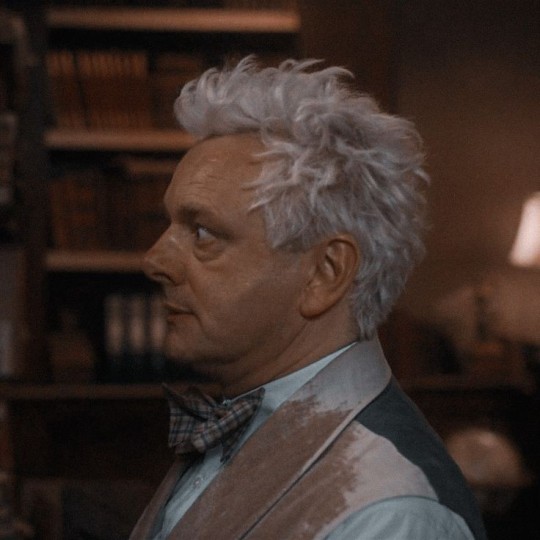
And it got me thinking a bit. The way the white practically bleeds from the edges of the neck, shoulders and buttons, going further and further, one day if he's persistent enough to wear it, it might even take over the entire vest. You could say that that, somehow, mirrors Heavens influence over Aziraphale. Slowly, slowly, biding their time, until it has completely ridden him of any colour. Until it has completely washed him of his identity, of his originality, of his character.
Take a look at his clothing when he's up in Heaven.
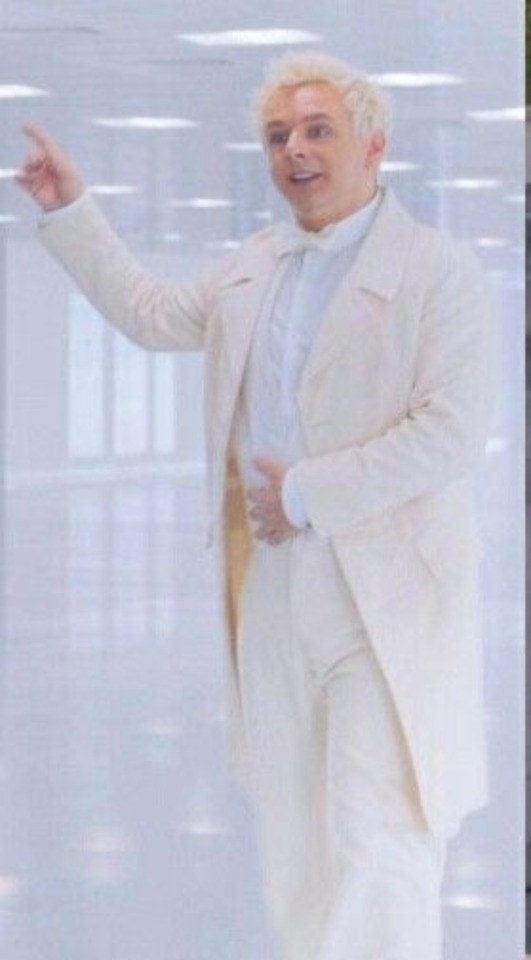
Completely and utterly white. Every piece of clothing he's wearing is pure and untarnished white. Upon entering Heaven, against his own accord, it has stripped him of his uniqueness, of anything that might distinguish him from any other angel who blindly follows orders and who's sole purpose is to do Heavens bidding.
Now, he could miracle the white patches on the vest away easily. But he doesn't want to.
The thing is. He likes the imperfect. He likes partaking in human activities and pleasures, like food, music, etc. Likes to indulge himself in earthly things Heaven would label as sinful or "sullying." And as someone who bas been on the receiving end of Heavens ridicule and passive aggression for millenia, as someone who for centuries has been told that he's underperforming and needs to do better, as someone who is all too aware of his own impurity by the standards an angel should hold and of the quite frankly unholy behaviour in performing immoral temptations and directly going against Heavens orders no more than a few times throughout the eras, it's no wonder he finds comfort in the imperfect.
He keeps the deteriorating edges because they are a perfect representation of his own internal feelings and image. After all, there's no rule that says he can't. And a big kudos to the costume department, for the patches perfectly encapsulate his religious trauma. Without it, he would probably be a very different person. He wouldn't be the same Aziraphale we know and love. The same way he likes being old-fashioned with his clothes and how that is a part of who he is, his trauma is a part of him as well, along with Heavens influence that has shaped him into who he is today, whether he likes it or not.
Every part of the vest illustrates Aziraphale's character and internal feelings, which brings me to another point I want to draw attention to, and that is the BACK of the vest.
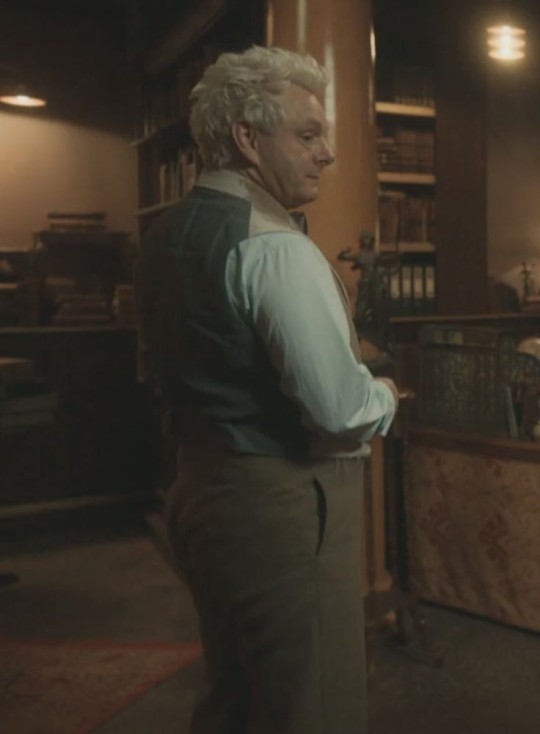
It's DARK. And I don't think I'm mistaken when I say that most of us didn't expect it to look like that from behind. We all just assumed that it would be the same beige colour as the front, which is in tune with the rest of his attire. After all, seeing him wearing a dozen different outfits all throughout history, all of them some shade of white, it was the logical conclusion.
But no.
It's not white. It's a dark, slightly viridian or a dark blue colour. "Dark blue suggests a more mysterious depth or ominous quality. Power and authority: Dark blue signifies power and responsibility. "
Not what we would have expected that colour at all. Similarly to how one wouldn't expect an angel to perform temptations or be gluttonous, or envious, or slothful, or hedonistic. Not at first glance anyway.
Not unless you look carefully.
Not unless you know him.

The coat almost acts like a cover. The light over the dark. Almost as if it's trying to hide something. The only times we see Aziraphale not wearing the coat is in his bookshop. Which is logical, of course. You wouldn't wear a coat indoors, obviously. Except he DOES. He wears the coat when he and Crowley are drunk, he wears it when he's reading Agnes Nutter, he wears it when Gabriel and Sandalphon pop in, he wears it when he's talking to the Metatron, he wears it when he's listening to Shostakovich, he even wears it at the Ritz where it would be custom to take off your coat while dining. And it's worth noting that during the events happening (at least in the first season), the season is summer. Which would make it quite ridiculous to be wearing so many layers everywhere you go and therefore risk boiling. But he still wears the coat.
The only times he doesn't wear it is in the first episode after the sushi, when he's all ALONE, and in season 2 at the bookshop when Crowley comes back and in 1941.
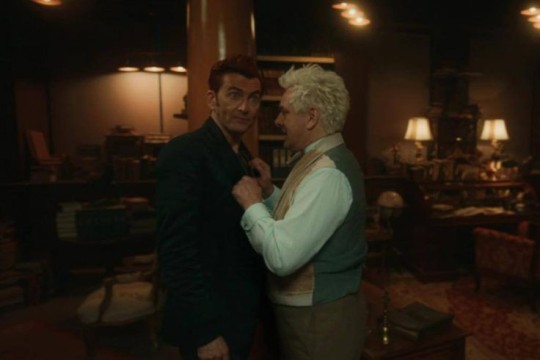
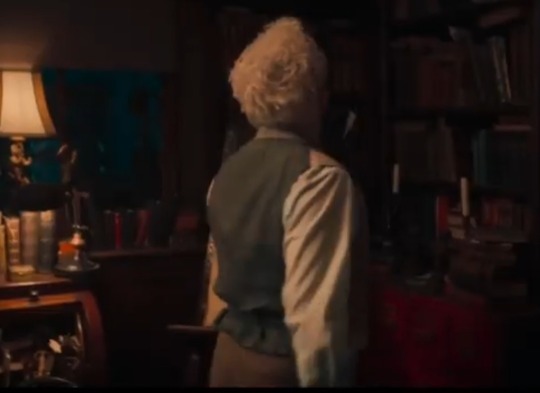
And there's something oh so personal about that.
I don't think it's a coincidence that the darker part is specifically the back of the vest. There's always been this natural human instinct to protect yourself by never ever turning your back on a foe. And I don't think this is a conscious effort on Aziraphale's part, but rather genius writing, directing and costume design, and anyone who's watched and read Good Omens knows that almost nothing is coincidental.
Note this is probably the first time Aziraphale has called Crowley his friend, seeing how uncertain and doubtful he was to even say the word in this scene and how quick he was to deny their friendship in the Shakespeare scene. And the camera immediately cuts from Crowley to Aziraphale, who is turned away, whose back is turned to Crowley oh so casually without a care in the world. Just before he calls him his friend. His back is turned, and so is the dark part of his vest.
The dark part he only shows in his bookshop, when he's alone and there's no one there. The part that he now only shows to Crowley as well. Crowley who knows him so well and who's been with him through everything. "I won't tell anyone if you won't." And "you said trust me""and you did". Just this small motion of Aziraphale depicts exactly how much trust he has in Crowley not only that he'll keep him safe and protected but to accept him just as he is, to not judge him, to not demean him for his imperfections as an angel. Practically mirroring Crowley's self-protection mechanism that is reflected in his motions to hide his eyes with his sunglasses (there's a wonderful meta on this by @simply-brightly-zee here )
And it might just be clothing, or it might just be genius symbolism, but note how self-aware Aziraphale is of his looks when Gabriel pops up.

The desire to impress is almost unconscious in this scene, and how does he go about doing it? By making sure he looks presentable. Presentable, despite the white patches and the vest that is falling apart, he doesn't even realise it. Therefore, it's clear Aziraphale puts thought into his clothes, whether consciously or unconsciously.
I personally dont think any of this (the coat, the patches, the way he turns his back, when, where and around who he's most comfortable) is a deliberate and intentional act on Aziraphales part but rather creative brilliance from the directors and producers. So him being shown to expose the back of the vest only in scenes with Crowley (and the one in s2 infront of an amnesiac Gabriel with the intelligence and awareness of a squirrel) is a master move on the costume department's part. The symbolusm being so small and imperceptible, but holding so much meaning. This small metaphor shows how much Aziraphale trusts Crowley and how comfortable he is around him. Crowley who knows about Aziraphale's transgressions, sins, unholy behaviours, lack of interest and dedication to his job, and overall "incompetence" as Aziraphale might put it and how he's "just enough of a bastard to be worth knowing". Crowley, who will accept him and love him no matter what. Not despite those things, but because of those things.
They have found their "own side".
Edit: Not that important, but I just want to mention how, despite being tattered and falling apart, the vest is still in perfectly good condition. No matter the white seeping in and draining its colour, the vest doesn't have a single seam torn, not a button lost, perfect as the day it was bought. No matter what it's been put through, it's still kicking, whether by miracle or sheer willpower. Very much like the person wearing it.
#good omens#goodomens#aziraphale#crowley#goodomenss2#good omens 2#ineffable husbands#good omens season 2#aziracrow#goodomenss2spoilers#good omens meta#good omens analysis#analysis
2K notes
·
View notes